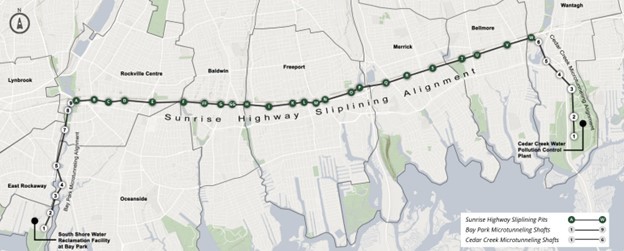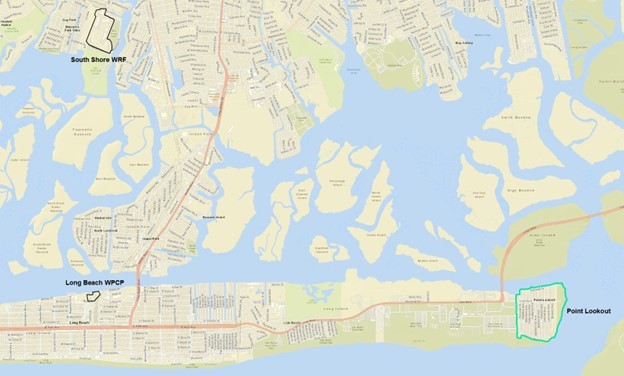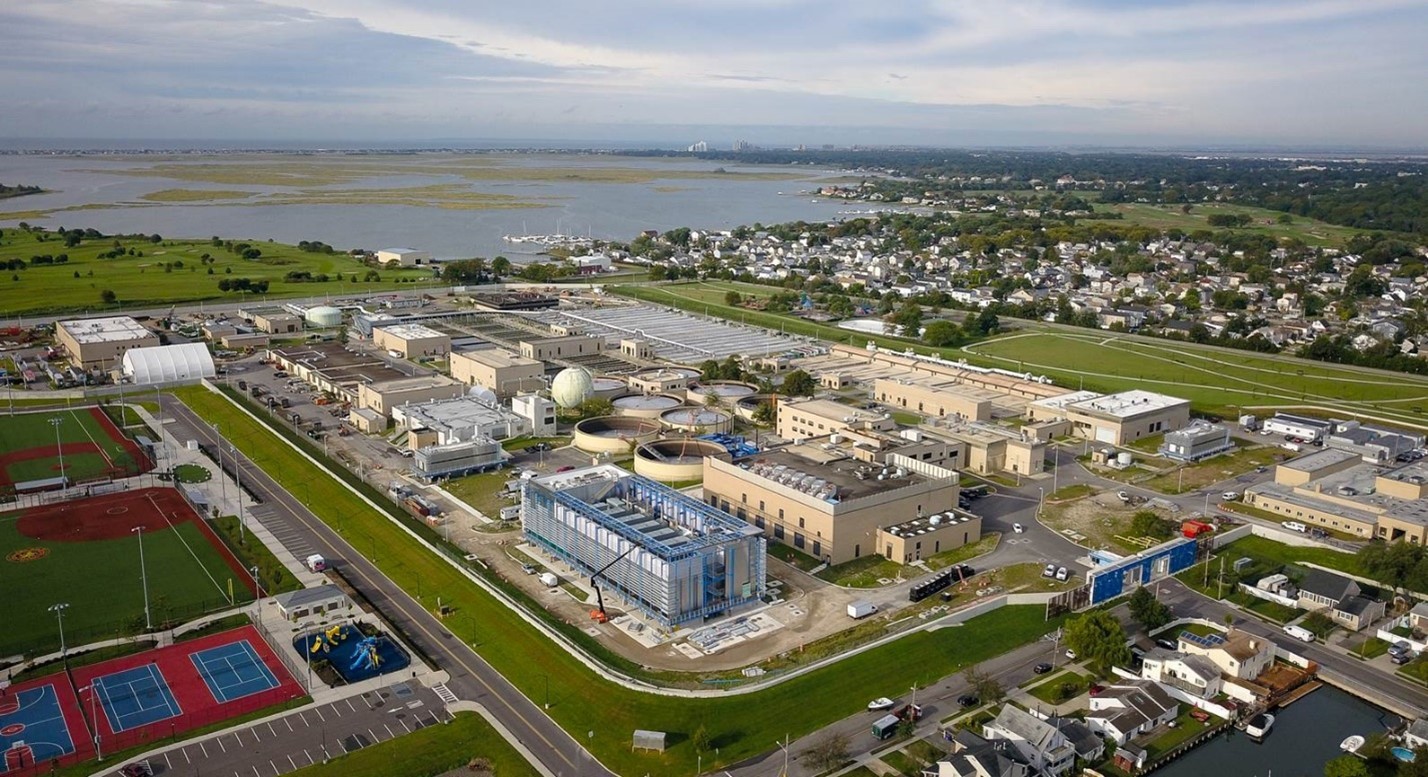Long Island Nitrogen Action Plan (LINAP) Newsletter |
Western Bays Reconstruction and Resiliency InitiativeNassau County is leading a series of resiliency and sustainability projects that will improve the water quality of the Western Bays. The regional vision includes nitrogen removal, ocean outfall discharge of treated effluent, and consolidation of local wastewater treatment plants. Water quality improvements will allow for the ecological recovery of the Western Bays and will enhance and expand water-based recreational and commercial opportunities. Collectively, these projects are the Western Bays Reconstruction and Resiliency Initiative. Bay Park Conveyance ProjectThe Bay Park Conveyance Project is underway with active construction across the 10.9-mile project corridor. The project is a partnership between the New York State Department of Environmental Conservation (DEC) and the Nassau County Department of Public Works. This innovative project will convey treated water from the South Shore Water Reclamation Facility (SSWRF), which currently discharges an average of 52 million gallons per day (MGD) of treated water into Reynolds Channel, to the Cedar Creek Water Pollution Control Plant (WPCP) ocean outfall pipe. The ocean outfall is approximately three miles offshore in the Atlantic Ocean. When complete, the project will divert as much as 75 MGD of treated water and up to 90 percent of the nitrogen loading from Reynolds Channel and the Western Bays each year, improving water quality, regional resiliency, quality of life and economic opportunities for nearby communities.
Photo Credit: Western Bays Constructors To build this conveyance, the project uses trenchless techniques, microtunneling and sliplining, to install new pipe deep below the ground, avoiding long trenches and surface disturbance. The project includes two microtunneling segments – one extending two miles from the SSWRF north to Sunrise Highway in Rockville Centre, and another extending 1.6 miles from Sunrise Highway in Wantagh to the Cedar Creek WPCP. The project is also repurposing 7.3 miles of an existing abandoned aqueduct beneath Sunrise Highway, using sliplining to install new smaller pipe into the larger host pipe. Since March 2022, approximately 40 percent of the 37,345 linear feet of new conveyance pipe is now installed beneath Sunrise Highway through sliplining and microtunneling advanced about 15 percent of the 19,679 linear feet of new conveyance pipe since April 2022.
Photo Credit: Western Bays Constructors The project utilizes a Design-Build project delivery method which substantially lowers the cost and shortens the construction schedule more than the traditional design-bid-build method. Design is over 90 percent complete and construction is underway on all project elements with anticipated project completion in 2024. Visit the Bay Park Conveyance Project’s website to learn more. Long Beach Water Pollution Control Plant Consolidation ProjectThrough an intermunicipal agreement between Nassau County and the City of Long Beach, the County is in the process of procuring construction services for the Long Beach Water Pollution Control Plant (WPCP) Consolidation Project. The scope of the project involves converting the Long Beach WPCP to a pump station and rerouting Long Beach wastewater – with an average flow historically of 5 MGD and current peak flow of about 16 MGD – to the newly upgraded SSWRF, where the wastewater will be treated more effectively once the treatment upgrades are implemented. The project is expected to be completed in 2025. Point Lookout Sewer StudyNassau County was awarded $2 million to conduct a feasibility study to construct sewer infrastructure for the Point Lookout area in the Town of Hempstead as part of a Long Island Regional Economic Development Award. This project aims to convert 500 residential and commercial septic systems to a sewage collection system connected to the Long Beach WPCP. The County is in the process of procuring professional services for the feasibility study.
Photo Credit: Esri (map), Hazen & Sawyer and Arcadis Program Management Joint Venture (location outlines and labels) South Shore Water Reclamation Facility (SSWRF) Resiliency UpgradesNassau County continues with major resiliency upgrades to the SSWRF, which was severely damaged by Hurricane Sandy. Flood protection upgrades include a berm and flood wall that protect the entire perimeter of the facility, flood gates on the north and south sides and stormwater pump stations to handle rainwater accumulation within the now fully enclosed facility. Additionally, all critical equipment and electrical distribution systems have been elevated to the recommended design elevation for the 500-year flood (0.2% annual exceedance probability flood). Nitrogen RemovalNassau County is implementing two projects designed to reduce the nitrogen concentration discharged from the SSWRF. The first project, Biological Nutrient Removal (BNR), was granted final completion in October 2021 and eliminates about 40 percent of the nitrogen discharged from the facility. The second nitrogen reduction project is Sidestream Centrate Treatment. This treatment method is expected to remove up to 85 percent of the nitrogen in the nitrogen rich liquid produced by the sludge dewatering process. The Sidestream Centrate Treatment project is currently under construction and is expected to start performance testing by November 2022. Together these upgrades could reduce nitrogen loads in treated water by up to 70 percent!
Photo Credit: Veolia North America Great Neck Water Control Pollution DistrictThe Great Neck Water Pollution Control District (GNWPCD) is a commissioner-run special district within the Town of North Hempstead. The GNWPCD’s 5.3 Million Gallon per Day treatment facility has provided sewage services for the Great Neck area since 1914, currently serving more than 25,000 residents and businesses. After significant upgrades to the facility over the past 8 years the District is now able to treat wastewater and remove nitrogen at a much higher level. Through advanced technologies the District’s nitrogen discharge is less than half of DEC’s allowed permit limit and conserves 27 million gallons of drinking water per year, through its water reuse system. As part of its continued nitrogen removal initiatives, the District has helped to eliminate septic use by connecting homes and businesses close to its borders. Last year the District connected the Americana Shopping Center which eliminated over 50 septic systems and now treats its 30,000 gallons per day. The North Shore University Hospital’s Advanced Surgical Pavilion in Manhasset will also be connected to the District’s sewer system. The Pavilion is currently under construction and is scheduled to be operational by the end of 2023. The District has completed a feasibility study for the sewering of Manhasset’s Business District. This project aims to connect 86 commercial and residential properties using a low-pressure sewer system. This year the Great Neck Water Pollution Control District received a $5 million grant from the Department of Environmental Conservation to move the project forward. The District is in the process of preparing a feasibility study for the unsewered portions of Great Neck Estates and Harbor Hills. The study will assess the connection of approximately 1,000 existing homes to sewers. The state-of-the-art treatment facility incorporates sustainable technology in its operation. The District has upgraded its anaerobic digesters, doubling the present methane production and tripling the amount of gas storage at the facility. The construction of three microturbine generators, allows the District to generate 50 percent of its electricity needs and 100 percent of its heating needs. The District also constructed a 2,500-square-foot grease receiving station which supports the microturbines by using cooking grease to increase their power generation capability. It also helps solve Long Island’s restaurant grease disposal challenges, by reusing the grease as a fuel source.
Photo Credit: Great Neck Water Control Pollution District To sign up for our LINAP Newsletter, visit our LINAP webpage or click here. |
Footer
Contact
STAY INFORMED
Enter your email address to receive email updates from the LIRPC:







